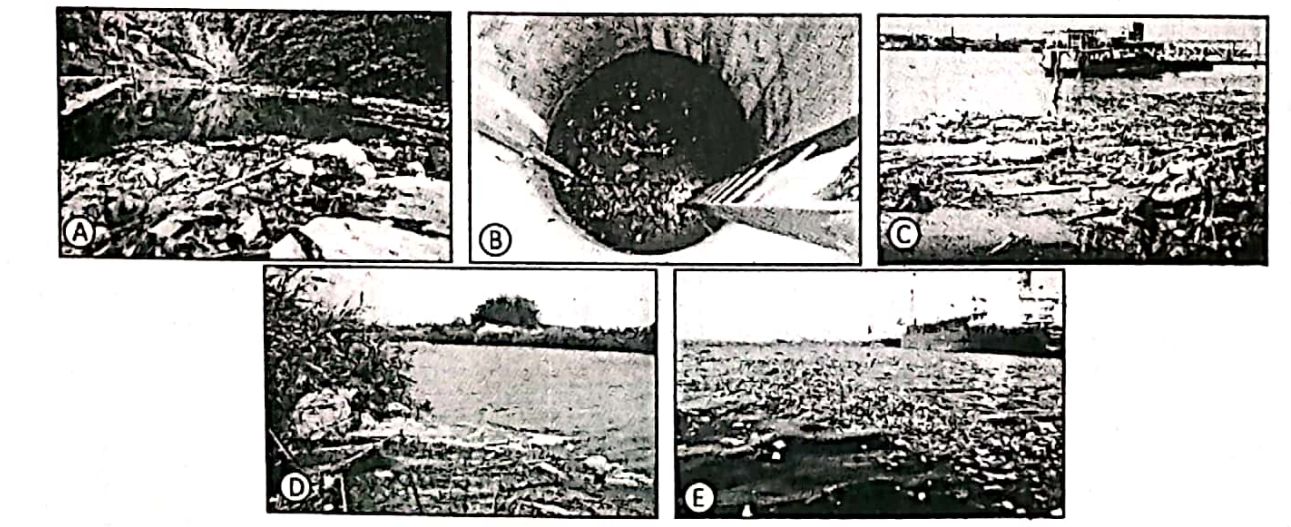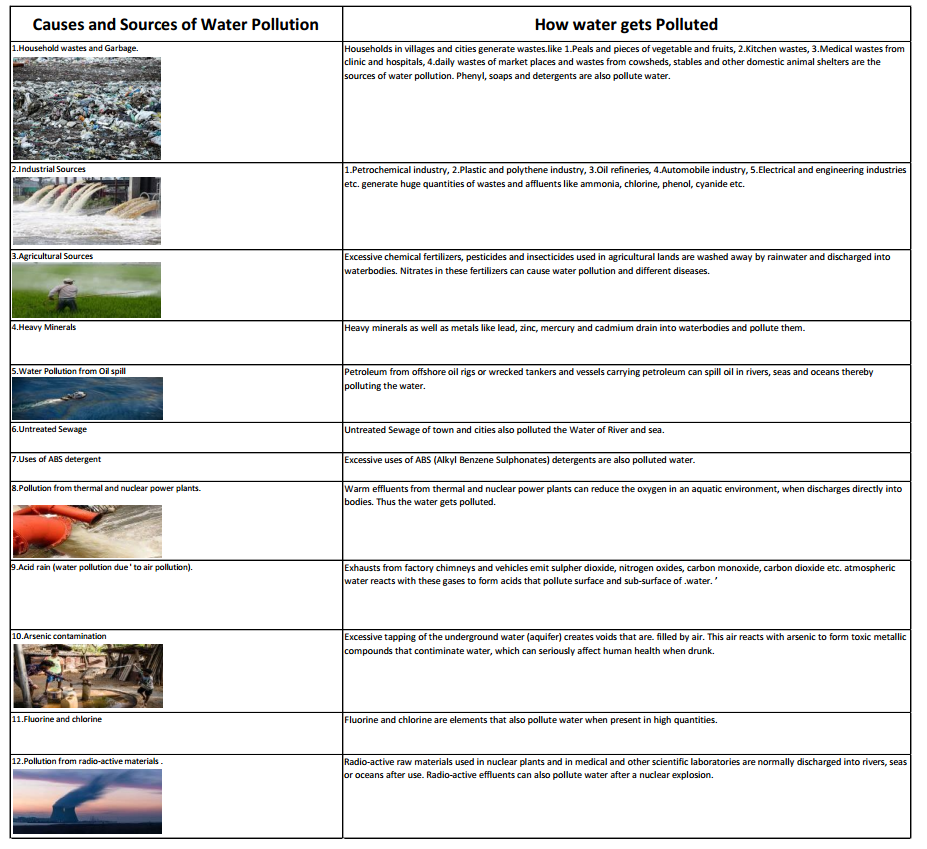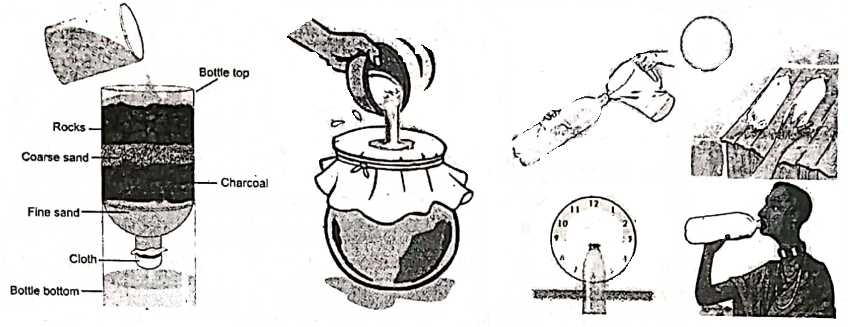Chapter 7 Water Pollution
What Is Pollution: The fouling of the environment by man, which makes it harmful for living organisms or reduces its amenity value is called pollution.
Pollution changes the physical, chemical or biological balance of the environment and has adverse effects on the normal functioning of all life forms, including humans.
Different Types Of Pollution: Pollution may be divided into two major categories :
- Physical Pollution And
- Non-Physical Or Social Pollution.
Physical pollution may be air pollution, water pollution, soil or land pollution, etc. Social pollution may be defined as a kind of pollution by which the quality of the social environment deteriorates. Population explosion, sociological pollution, economic pollution etc.
Read and Learn More WBBSE Notes for Class 7 Middle Class Geography
On the basis of area and source pollution may be categorised into-
- Urban pollution,
- Rural pollution,
- Agricultural pollution and
- Industrial pollution.
“WBBSE class 7 geography chapter 7 notes”
What Is Water Pollution: According to the President’s Science Advisory Committee, Washington (1965), water pollution is, “Alteration in physical, chemical and biological characteristics of water which may cause harmful effects on human and aquatic life.”
” class 7 sst geography chapter 5″
According to the definition of the World Health Organisation (1966), water pollution occurs when foreign materials either from natural or other sources are contaminated with water supplies and may be harmful to life because of their toxicity, reduction of normal oxygen level of water, aesthetically unsuitable effects and spread of epidemic diseases.
When Water Is Polluted: When different unsuitable organic matters, germs and force chemicals make water unsuitable for human beings and other members of the biotic world and also make it unhabitable for aquatic life, it is said to be polluted.
Different Types Of Water Pollution: There are mainly five types of water pollution. These are as follows:
- Surface Water Pollution,
- Ground Water Pollution,
- River Water Pollution,
- Lake Water Pollution and
- Sea Water Pollution.

Chapter 7 Water Pollution Sources Of Water Pollution
Point Source: These direct sources of water Pollution may be controlled by the making of laws. These are-
- Factories,
- Thermal Power Plant and
- Atomic Power Plants etc.
Non-Point Source: These indirect sources of water pollution cannot be identified easily. So these are not controlled by the laws Example., Agricultural land, Forests, Dirty water of roads etc.
Pollutants: Something that pollutes the environment is called a pollutant. Pollutants are substances which cause pollution. Pollutants may be solid, liquid or gaseous substances.
Water Pollutants: Something that pollutes and deteriorates the quality of water is called water pollutants. These pollutants may be natural or anthropogenic.
“water pollution WBBSE class 7 geography notes”
Types Of Water Pollutants :
- Industrial Pollutants: Chloride, sulphides, carbonates, nitrates, heavy metals, various organic or inorganic chemical compounds etc.
- Agricultural Pollutants: Chemical fertilizers, insecticides, pesticides etc.
- Urban Pollutants: Sulphates, nitrates and Potassium contained in urban sewage water.
Water pollutants may also be divided into
- degradable or organic pollutants such as sewage, and leaf litter and
- non-degradable pollutants, mainly toxic solid substance such as plastic.

Chapter 7 Water Pollution Causes Of Water Pollution
1. Natural Causes :
- Deposition of silt and dust,
- Decomposition of organic matters,
- Acid rain (water pollution due to air pollution).
2. Anthropogenic Causes :
- Household wastes and garbage,
- Industrial wastes and effluent poured into rivers.
- Agricultural garbage uses chemical fertilizers, pesticides, insecticides etc
- Heavy minerals (lead, mercury, cadmium) etc.
- Oil spillage from tankers,
- Untreated sewage,
- Uses of ABS detergent (Alkyl Benzene Sulphonates),
- Warm effluent of thermal power plants and nuclear power plants,
- Radioactivity
- Arsenic contamination
- Fluorine and chlorine.
“exercise 7 solved questions on water pollution class 7”
In the following table, the important causes/sources of water pollution are mentioned and indicate how water gets polluted.

Chapter 7 Water Pollution Water Born Diseases
The diseases such as Diarrhoea, Cholera, Dysentery, Typhoid, Polio, Jaundice etc. are caused by polluted and contaminated water.
Causes Of A Few Diseases Which Are Created By Water Pollution.
“WBBSE class 7 geography chapter 7 important questions”
| Name of the Diseases | Causes | Problems |
| 1. Arsenicosis | 1. Due to the heavy amount of arsenic in underground water | 1. Weakness, rough skin, cramps In muscle. |
| 2. Black foot disease. | 2. Due to the heavy amount of arsenic in underground water. | 2. Besides skin disease, anaemia, and liver and lung cancer can attack. |
| 3. Flourosh | 3. Fluoride pollution. | 3. Problem with teeth, bones etc |
| 4. Minamata disease | 4. Mercury pollution. Problems. | 4. Loss of eye-sight, loss of sense of brain. |
| 5. ItaMtai | 5. Due to cadmium pollution. | 5. High blood pressure, and kidney damage. |
| 6. Dyslexia | 6. Due to an excessive amount of lead | 6. Decrease of haemoglobin, weakness of muscle vomiting tendency. |
Chapter 7 Water Pollution A Few Specific Incidents Of Water Pollution
In 1932, along the coast of Minamata Bay in Japan liquid waste of mercury was thrown. Due to this dreadful mercury pollution in water, Innumerable people and animals died for about three decades.
In 1991, at the time of the Gulf war, many oil wells were ignited in Kuwait by Iraq. A large quantity of mineral oil polluted the water of the Persian Gulf causing the death of countless marine creatures.
Due to the excessive amount of arsenic in underground water of the districts of Malda, Nadia, Burdwan, Hooghly, Howrah, North and South 24 Parganas of west Bengal black wounds are formed and this is called ‘Black foot’ disease.
Due to the water pollution of the Haldi river after the formation of the petrochemical industry at Haldia, the frequent visit of Hilsa fish at the mouth of the Haldi river has decreased.
“definition and causes of water pollution class 7”
Due to Eutrophication fish and other aquatic animals die as the percentage of oxygen in water decreases. The pisciculture at the fisheries of the wetlands of East Kolkata has decreased due to the use of pesticides.
For this reason, a large quantity of fish has died at Kuttuner of Kerala, Kolleru of Andhra Pradesh and Chilka of Odisha.
Water Is Life: Man cannot live without drinking water, perhaps that’s why water, in other words, is called ‘life’. The supply of water for bathing, cooking, drinking, irrigation and industrial purposes is very essential and important.
Crisis Of Fresh Water: Fresh water is the most important natural resource. Though about 71% of the earth’s surface is covered with water bodies, still demand for freshwater remains the main problem for people all over the world.
97% of the water on earth is the saline sea or ocean water out of the remaining 3%, 2% is trapped in ice caps. Only 1% remains in the rivers, lakes underground aquifers and other freshwater bodies.
States Suffering From Acute Water Crisis: Due to overuse and pollution of water severe crisis of fresh water has affected some parts of the world such as some parts of the states of Africa, Australia, West Asia and South America.
“effects of water pollution on environment and health”
Our country India is a land of rivers but presently highly polluted water from the rivers like the Ganges, Krishna, Kaveri, Godavari and Yamuna is not usable as drinking water.
Purifying Water: Recently, even though there is the availability of drinking water for most people in India, the only source of drinking water in remote areas is the river and ponds.
These are full of water but that water is dirty, polluted and not suitable for using as well as drinking. So purifying water is very essential. There are some easy methods by which the purification of water is possible.
- Clean water from the upper layer may be used in the case of turbid water.
- Most of the bacteria in the water are destroyed by boiling the water for 10 minutes at 100°C temperature.
- Bacteria are also destroyed if an adequate amount is mixed with water.
- Different types of plants peas and pulses help to deposit all the sediments in the lower level of the container.
- Water may be purified in several ways with the help of charcoal, fine sand, pebbles and stone heaps.
- If water is poured in to clean plastic bottle and kept in sunlight for six to seven hours, then water as pure as clean boiled water can be obtained.

Chapter 7 Water Pollution Prevention Of Water Pollution
Strict controls are needed to prevent water pollution. These are as follows:
- Household wastes and garbage should not be thrown directly into ponds, rivers or seawater.
- Bathing of cattle and washing of clothes should be banned.
- Excessive chemical fertilizers, pesticides and insecticides should not be used in agricultural fields.
- Industrial effluents should be effectively recycled so that these pollutants are not released into the water.
- Polluted wastewater from urban areas should be thrown into rivers and seas only after treating it properly.
- Waste and hot water from thermal or nuclear power plants should be cooled and then thrown into the river or sea.
- Radio-active, chemical and biological pollutants can be removed from water by absorption, electrolysis, ion exchange and reverse-osmosis methods.
- Pollution of floating oil in the sea can be prevented by the use of various bacteria, algae and chemicals.
- For pure and safe drinking water, well and tube well water should be examined regularly and scientifically.
- Strict laws should be enforced and persons violating the provisions of pollution control should be penalised.
- Mass social awareness should be indicated regarding the nature and effects of water pollution and remedial measures.
“types of water pollutants WBBSE class 7 geography”
What Can Be Done By The Student Of Class Seven?
- Household wastes and liquid wastes should be disposed of in such a place so that it would not mix with pure water.
- Vegetable plants, plants bearing flowers and fruits should be planted in the house garden and school garden.
- They may use things that will not harm the environment (soap, shampoo, detergent etc.)
- They may close the open tap or broken tap near their school or house.
- They can submit a description of their experience to their school magazine about the importance, purification and supply of water.
- Much awareness may be increased by the students if they paste beautiful posters about water pollution water conservation and frequent recycling of water in the surrounding areas of their school or home.
- They should think what other ways they can adopt to prevent water pollution.
- They should try to get more information about different ways in which water can be reused.
